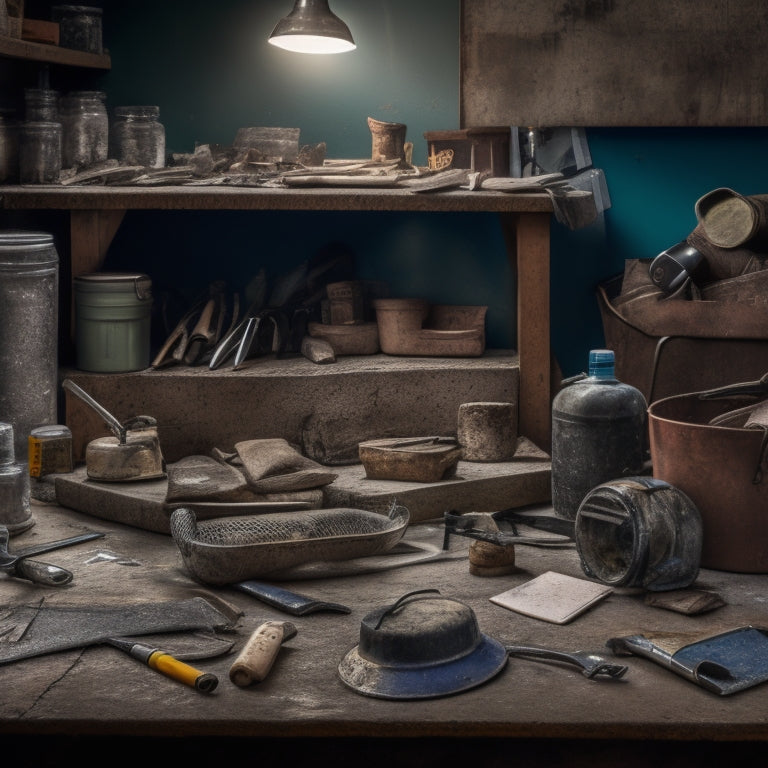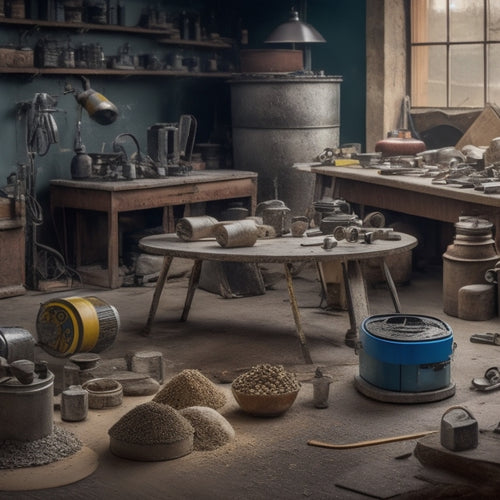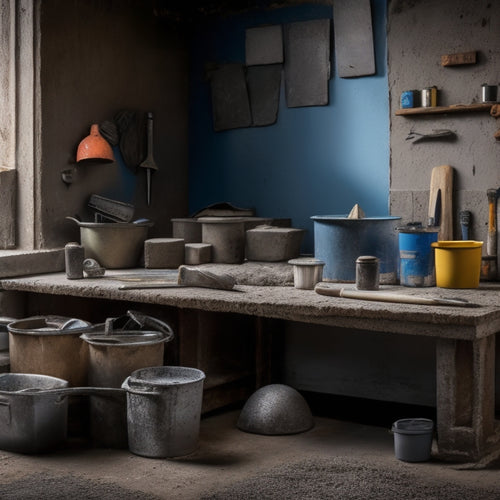
Essential Tools for Quick Fix Concrete Repairs
Share
When tackling quick fix concrete repairs, you'll need a solid arsenal of specialized tools to efficiently drill, cut, grind, mix, and finish concrete surfaces. High-torque tools, rotary hammers, and diamond blades are essential for drilling and cutting through dense concrete, while angle grinders and demo saws help remove old coatings and make precise cuts. A reliable demolition hammer and concrete mixing essentials, such as a cement quantity calculator, are also must-haves. With the right tools, you'll be equipped to tackle anything from patching cracks to resurfacing entire slabs - and by exploring further, you'll discover the specific tools and techniques to get the job done quickly and effectively.
Key Takeaways
• High-torque power tools, like rotary hammers and hammer drills, are essential for drilling and cutting concrete efficiently.
• Angle grinders and diamond blades are necessary for removing old coatings and rough surfaces in concrete repairs.
• Demolition hammers with high impact energy and speed are required for efficient concrete breaking and demolition.
• Accurate concrete mix design, including cement, aggregate, and water proportions, is crucial for long-lasting repair jobs.
• Specialty tools, such as edgers, jointers, and tamping rods, are vital for achieving professional finishes in concrete repairs.
Best Power Tools for Drilling
You'll frequently rely on high-torque power tools to drill through concrete, as they provide the necessary force to penetrate its dense, unforgiving surface.
When it comes to choosing the best drill types for concrete repairs, you'll want to opt for rotary hammers or hammer drills. These drill types are designed to withstand the rigors of concrete drilling and deliver the necessary power to drive drill bits through the material.
The type of drill bit you use is equally important. You'll need bits specifically designed for concrete drilling, such as masonry bits or carbide-tipped bits. These bits are engineered to withstand the abrasive nature of concrete and maintain their cutting edge even in the toughest drilling conditions.
For larger holes, you may need to use a core bit, which is designed for drilling precise, large-diameter holes in concrete.
High-Torque Impact Wrenches Needed
Tackling stubborn concrete anchors and bolts demands high-torque impact wrenches that can generate the intense force required to loosen or remove them. You'll need an impact wrench that can deliver high torque benefits, such as increased power and efficiency, to get the job done quickly and effectively.
When choosing an impact wrench, look for one with a high torque rating, typically measured in foot-pounds (ft-lbs) or Newton-meters (Nm). A higher rating indicates greater force output.
To guarantee your impact wrench continues to perform at its best, regular maintenance is essential. You should regularly inspect and clean the tool, checking for signs of wear and tear on the motor, gearbox, and anvil.
Proper storage and handling are also vital to prevent damage and extend the tool's lifespan. Additionally, follow the manufacturer's guidelines for impact wrench maintenance, including lubrication and replacement of worn parts.
Essential Concrete Cutting Tools
When concrete repair projects require precise cuts or demolitions, having the right concrete cutting tools in your arsenal is essential for achieving professional results efficiently.
You'll need a range of tools to tackle various concrete cutting tasks, from demo saws to rotary hammers and concrete cut-off machines.
Each tool is designed for specific concrete cutting techniques, so it's vital to choose the right one for the job.
For instance, demo saws are ideal for making straight cuts in concrete slabs, while rotary hammers are better suited for breaking up concrete walls or floors.
Quick Fix Concrete Mixing Essentials
When you're faced with a concrete repair job, you'll need to get the mix just right.
You'll want to start by determining the best concrete mix design for the specific task at hand, taking into account factors like strength, durability, and workability.
Next, you'll need to calculate the ideal mixing water ratio and cement quantity to guarantee a strong, long-lasting repair.
Concrete Mix Design
You'll need to precisely calculate the proportions of cement, aggregate, and water to guarantee your quick fix concrete mixture achieves the required strength and durability. This is where concrete mix design comes in – a critical step that guarantees your repair job lasts.
To get it right, you'll need to take into account factors like the type of cement, aggregate size and gradation, and the intended use of the concrete.
When designing your mix, don't forget to account for concrete additives that can enhance performance. These might include retarders to slow setting times, accelerators to speed up hardening, or air-entraining agents to improve workability.
The right additives can make all the difference in achieving the desired mix consistency. Aim for a mix that's workable yet not too runny, as this can compromise strength.
Mixing Water Ratio
With your mix design calculated, it's time to focus on the mixing water ratio, an essential component that greatly impacts the strength and workability of your quick fix concrete mixture.
The ideal water ratio is vital, as it affects the concrete's hydration process, strength, and durability. Too little water, and the mixture will be too stiff; too much water, and it'll be too runny.
Here are three key considerations to keep in mind when determining your mixing water ratio:
-
Water absorption: The type and amount of aggregate used will influence the water absorption rate, affecting the overall water requirement.
-
Mixing techniques: The method and duration of mixing will impact the distribution of water within the mixture, influencing the final product's consistency.
-
Environmental factors: Temperature, humidity, and wind will all impact the evaporation rate of the mixing water, requiring adjustments to the ratio accordingly.
Cement Quantity Calculator
Accurately determining the cement quantity is essential in quick fix concrete mixing, as it directly affects the mixture's strength, durability, and overall performance. You can't afford to get it wrong, as excess or deficient cement can compromise the repair's integrity.
That's where a reliable cement quantity calculator comes in. This tool allows you to estimate the exact amount of cement required for your specific repair job. By inputting the concrete yield calculation, you'll get an accurate cement volume estimation.
When choosing a cement quantity calculator, look for one that takes into account factors like the concrete's compressive strength, mix design, and aggregate proportions. This guarantees you're getting a precise calculation tailored to your specific needs.
With a good calculator, you'll avoid over- or under-ordering cement, saving you time, money, and resources. By mastering cement quantity calculation, you'll be able to mix concrete with confidence, knowing you're getting the right consistency and strength for your quick fix repairs.
Top Hammer Drills for Concrete
When tackling concrete repairs, high-quality hammer drills prove essential for efficiently drilling holes and anchors in this unforgiving material. These powerful tools deliver high-torque output, making short work of even the toughest concrete jobs.
As you prepare for your concrete repair task, consider the following key features to look for in a high-quality hammer drill:
-
High-torque output: Look for drills that can deliver up to 20 joules of impact energy to tackle demanding concrete applications.
-
Variable speed control: A drill with adjustable speed settings allows you to fine-tune your drilling performance for ideal results.
-
Ergonomic design: A comfortable, balanced design reduces operator fatigue and improves overall drill performance.
With a high-quality hammer drill in your arsenal, you'll be able to tackle even the most challenging concrete repairs with confidence.
Fast and Efficient Grinding Tools
How do you achieve fast and efficient removal of old coatings, rough surfaces, and excess material in concrete repairs? You need the right grinding tools for the job.
Angle grinders are a staple in any concrete repair toolkit. These powerful machines are designed to tackle tough surfaces, making quick work of old coatings and rough concrete. With the right diamond blade, you can achieve precise cuts and efficient material removal. Diamond blades are specifically designed for concrete grinding, providing a faster and more aggressive cut than traditional abrasive blades.
When choosing an angle grinder, consider the power output, RPM, and ergonomics. A higher power output will allow you to tackle tougher surfaces, while a comfortable grip and balanced design will reduce fatigue during extended use.
Diamond blades come in various sizes and grit levels, so select the one that best suits your specific repair needs. With the right angle grinder and diamond blade combination, you'll be able to achieve fast and efficient grinding, saving you time and effort on your concrete repair projects.
Reliable Demolition Hammer Options
You'll need a reliable demolition hammer to dismantle and remove concrete structures, break up slabs, and demolish walls, making it an indispensable tool for concrete repair projects.
When choosing a demolition hammer, consider the following essential features:
-
Power and speed: Look for a hammer that delivers high impact energy and speed to efficiently break up concrete.
-
Ergonomic design: A comfortable grip and balanced design reduce fatigue and improve control, guaranteeing you can work safely and effectively.
-
Durable construction: A robust build with high-quality materials guarantees your hammer withstands the rigors of concrete demolition.
Specialty Tools for Concrete Finishing
When you're working on concrete finishing, you'll need to precision-craft the edges, joints, and surfaces to achieve a professional-grade finish.
You'll require specialized tools to accomplish this, including edging and jointing tools that help you create crisp, clean lines.
Next, you'll need to smooth and float the concrete to eliminate imperfections, and tamp it to achieve the desired texture and consistency.
Edging and Jointing Tools
Edging and jointing tools are precision instruments designed to refine the appearance and functionality of concrete surfaces by creating clean edges and defined joints.
As you work on concrete repairs, these tools will become essential in achieving a professional finish.
Here are three must-have tools in your edging and jointing arsenal:
-
Edger: A handheld tool with a curved or angled blade, used to create a clean, defined edge along sidewalks, driveways, or building foundations.
-
Jointer: A specialized tool used to create and clean joints in concrete, ensuring proper spacing and alignment for maximum structural integrity.
-
Joint chisel: A heavy-duty tool used to remove old or damaged jointing materials, preparing the surface for new jointing materials and ensuring a strong bond.
When mastering edging techniques, you'll need to reflect on the type of jointing materials you're working with, as well as the specific requirements of your project.
By selecting the right tools for the job, you'll be able to achieve a high-quality finish that meets your standards.
With these essential tools at your disposal, you'll be well on your way to producing professional-grade concrete repairs that stand the test of time.
Tamping and Finishing
Three essential tamping and finishing tools are necessary to achieve a smooth, even finish in your concrete repairs, guaranteeing the surface is compacted and free of imperfections. These tools will help you master various tamping techniques and finishing methods to produce high-quality results.
| Tool | Function | Benefit |
|---|---|---|
| Tamping Rod | Compacts and densifies concrete | Guarantees a solid, stable surface |
| Finishing Trowel | Applies and smooths out concrete | Allows for precise control and even distribution |
| Edger | Finishes and shapes concrete edges | Creates clean, defined edges and joints |
When selecting a tamping rod, consider the length and material to guarantee it can effectively compact the concrete. For finishing trowels, choose one with a comfortable grip and a blade that suits the size of your repair. Edgers come in various shapes and sizes, so select one that fits your specific needs. By incorporating these three tools into your concrete repair arsenal, you'll be able to achieve a smooth, even finish that meets professional standards.
Smoothing and Floating
You'll next need to focus on smoothing and floating techniques, which require specialized tools to achieve a high-gloss finish and remove any imperfections that may have developed during the tamping and finishing process. These techniques are essential in concrete repair, as they guarantee a uniform, even surface that's both aesthetically pleasing and durable.
To master smoothing and floating methods, you'll need the following tools:
-
Power trowels: These electric or gas-powered tools are designed for large areas and feature rotating blades that help to smooth and flatten the concrete surface.
-
Float blades: Attached to a long handle, these flat, rectangular blades are used to apply even pressure and remove excess material, achieving a smooth finish.
-
Edger tools: These handheld tools are used to smooth and finish concrete edges, corners, and tight spaces where larger tools can't reach.
Frequently Asked Questions
Can I Use Regular Drill Bits on Concrete?
When you're tackling concrete drilling techniques, you might wonder if regular drill bits will cut it. Unfortunately, they won't.
Regular drill bits are designed for wood, metal, or drywall, not concrete. They'll quickly dull or break, wasting your time.
Instead, you'll need specialized drill bit types, like carbide-tipped or diamond-coated bits, which are specifically designed to handle the hardness of concrete.
These bits will provide the necessary power and precision for successful concrete drilling.
How Do I Prevent Concrete Dust From Spreading?
You're likely aware that concrete dust is a major occupational hazard, with the CDC reporting that over 2 million construction workers are exposed to it every year.
To prevent concrete dust from spreading, you'll want to implement effective dust control methods. One key strategy is concrete dust suppression using water misting or fogging systems.
These systems reduce airborne particles, minimizing the risk of respiratory issues and making cleanup easier.
What Safety Gear Is Necessary for Concrete Repairs?
When working with concrete, you'll need to prioritize your safety above all else.
You're already taking steps to contain the dust, but what about protecting yourself from airborne particles and debris?
You'll need to wear safety goggles to shield your eyes from flying fragments and a respirator mask to filter out harmful dust and particles.
Don't skip these vital pieces of safety gear - they're essential for a safe and successful repair job.
Can I Mix Concrete by Hand for Small Repairs?
Did you know that the ancient Egyptians mixed concrete by hand to build the Great Pyramids? You're in good company!
For small repairs, you can definitely mix concrete by hand. Use a sturdy mixing bucket and a mixing stick or trowel to combine cement, sand, and water.
Employ effective mixing techniques, like folding and scraping, to achieve a consistent mix. With the right hand tools and a bit of elbow grease, you'll be ready to tackle small repairs in no time.
How Often Should I Maintain My Concrete Repair Tools?
To extend tool longevity, you should establish a regular maintenance schedule.
For concrete repair tools, it's essential to clean them thoroughly after each use and store them in a dry place.
You should also lubricate moving parts and sharpen cutting edges regularly.
Aim to perform a deep clean and inspection every 3-6 months to identify any worn or damaged components that need replacement.
Conclusion
You've got the goods: a gamut of gadgets geared for quick fix concrete repairs.
From drilling to demolishing, cutting to curing, these top-tier tools will tackle tasks with precision and pace.
Whether you're a seasoned pro or DIY dynamo, this arsenal of equipment will accelerate your workflow, ensuring flawless fixes and fantastic finishes.
With these essentials at your fingertips, you'll be concrete-confident, conquering cracks, crumbles, and crumbling concrete with ease.
Related Posts
-

What Tools Do I Need for Concrete Wall Repair
As you prepare for a concrete wall repair job, you'll need a variety of tools to guarantee a successful outcome. Star...
-

Top DIY Concrete Grinding and Polishing Tools
When selecting DIY concrete grinding and polishing tools, you'll want to take into account a range of factors to guar...
-

Top Tools for Beginners in Concrete Masonry Coating
You're about to begin a concrete masonry coating project, and having the right tools is essential. Start with essenti...


